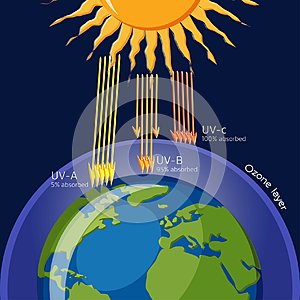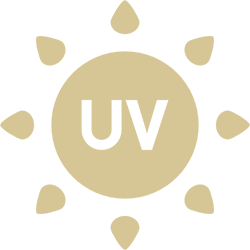Ultraviolet radiation
Ultraviolet radiation (other names: ultraviolet radiation, ultraviolet rays, ultraviolet light, UV(-) radiation/radiation/rays/light, radiation/radiation/rays/UV light; as wave: ultraviolet wave/waves, UV wave/waves; as part of the electromagnetic spectrum: ultraviolet spectrum, UV spectrum, ultraviolet band, UV band) is a flow of photons in a wavelength from 10 nm to 400 nm, that is, shorter than visible light but longer than soft X-rays.
It is divided into near (CUV, 200–400 nm), far or vacuum (FUV, 100–200 nm) and extreme (EUV or XUV, 1–31 nm). The ultraviolet region is divided into UV-A with a wavelength of 315 nm to 400 nm, UV-B with a wavelength of 280 nm to 314 nm and UV-C with a wavelength of 10 nm to 279 nm.[1] It was discovered in 1801 by the German physicist J. W. Ritter.
For organisms on Earth, the most intense source of UV radiation is the Sun. Earth's atmosphere and magnetospheric envelope effectively absorb most of this radiation. The absorption efficiency decreases with decreasing wavelength: while it absorbs practically 100% in the UV-C region, it is only 50-60% in the UV-B region and 30% in the UV-A region. The UV spectrum hitting the Earth's surface is made up of 90-99% UV-A radiation and 1-10% UV-B radiation. For every 300 m of height, the intensity of UV radiation increases by 4%. At an altitude of 1,500 m, it is 20% higher than at sea level.
UV radiation is necessary for humans for the synthesis of vitamins D2 and D3.
A few tens of minutes a day are enough to create the necessary amount.
Excessive exposure of the skin to UV-A and UV-B radiation (tanning) leads to skin damage. UV-A radiation causes skin aging and negatively affects the body's defense system. Excessive exposure of the skin to UV-B radiation causes skin burning (redness). With intensive and long-term exposure, it can lead to skin tumors. One way to protect the skin from the negative effects of UV radiation is to use protective creams with a higher UV factor.

Ultraviolet radiation affects cells through many mechanisms. Irradiation with ultraviolet rays causes the inactivation of intracellular enzymes, slows down cell division and induces the emergence of natural mutations. Some animals are more sensitive to it than others, for example for some (earthworms - Lumbricidae) it has even fatal effects. The most sensitively reacting building materials of living organisms to UV radiation are unsaturated organic compounds and most of them those with conjugated double bonds. They are mainly proteins (among them especially the amino acids tyrosine and tryptophan), nucleic acids (mainly their nitrogenous bases) and some pigments. Nucleic acids absorb UV radiation significantly more than proteins. Because the penetration of UV radiation is relatively small, it affects only the surface layers of the human body and manifests itself on the skin and eye.
UV radiation is used in various fields and medicine:
mountain sun - (lamp - artificial source)
by application to difficult-to-heal wounds, ulcers, bedsores, also in dermatology for skin diseases (eczema, psoriasis)
prevention and treatment of rickets, when whole-body irradiation is performed 1 to 2 times a week
treatment of osteoporosis
sterilization of the environment (so-called germicidal lamps with λ=253.7nm) and also as a primary source of radiation in discharge lamps
sterilization of water in waterworks before discharge into the water distribution system, but also e.g. in garden ponds, unless, for the sake of the fish, anti-algae chemicals are used

